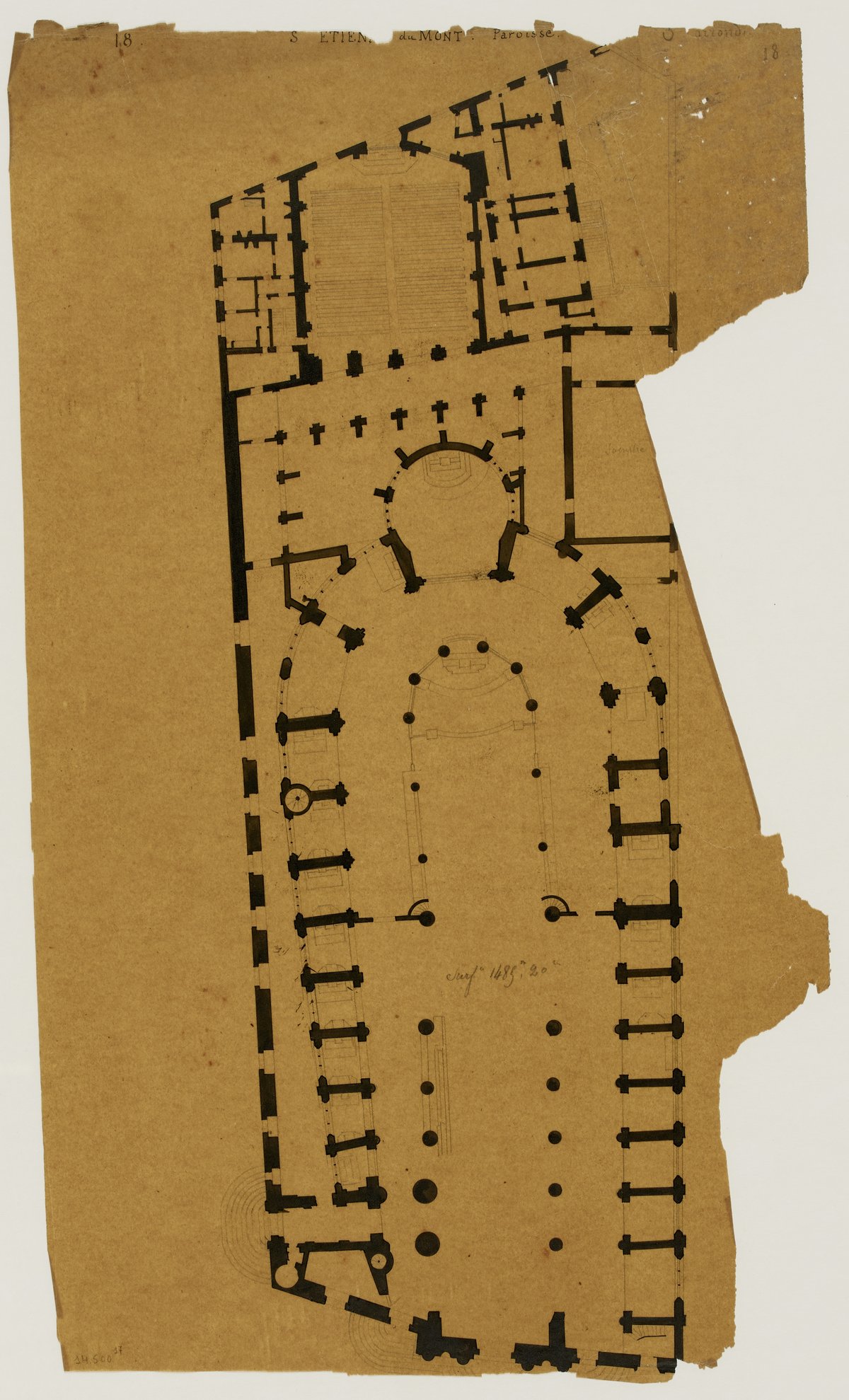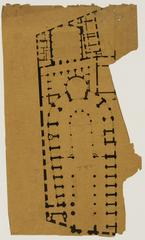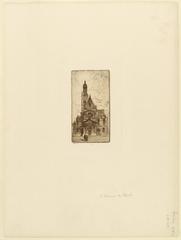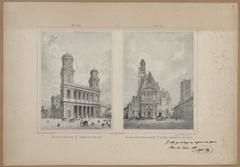
Saint-Étienne-du-Mont: Visiting Hours, Tickets, and Comprehensive History Guide
Date: 14/06/2025
Introduction
Nestled in the Latin Quarter, Saint-Étienne-du-Mont is one of Paris’s most fascinating historical and architectural treasures. Built between 1492 and 1626, the church uniquely combines Flamboyant Gothic and Renaissance styles, making it a key destination for anyone interested in the city’s religious, artistic, and cultural evolution. Beyond its architectural intrigue, Saint-Étienne-du-Mont is renowned as the shrine of Saint Geneviève—the patron saint of Paris—and as the resting place for notable figures including Blaise Pascal and Jean Racine. Its rare architectural features, such as Paris’s only surviving jubé (rood screen), and its vibrant cultural life, including concerts and cinematic appearances, offer visitors an immersive journey into the heart of Parisian heritage (Sacred Destinations; France Travel Planner; Paris Promeneurs).
This guide provides everything you need to plan your visit: hours, tickets, accessibility, highlights, practical tips, and historical context.
Table of Contents
- Early History and Religious Significance
- Architectural Evolution and Highlights
- Notable Burials and Cultural Impact
- Modern Role and Visitor Experience
- Practical Visitor Information
- Frequently Asked Questions (FAQ)
- Summary and Visit Tips
- References
Early History and Religious Significance
Origins and the Legend of Saint Geneviève
Saint-Étienne-du-Mont was constructed on the site of an older abbey founded by Clovis, the first Christian king of the Franks, after his conversion in the late 5th century. The abbey became the center of devotion to Saint Geneviève, celebrated for her leadership during Attila the Hun’s siege in 451 CE. Over centuries, her relics attracted countless pilgrims, making the church a symbol of Parisian resilience and faith (Sacred Destinations).
Although the French Revolution led to the destruction of much of the original shrine and the burning of Saint Geneviève’s relics, her sarcophagus and some relics survived and are now enshrined in a chapel within the church, preserving its status as a key pilgrimage site (Un Jour de Plus à Paris).
Architectural Evolution and Highlights
Construction Timeline and Styles
The church’s construction spanned more than 130 years, reflecting an evolution from Flamboyant Gothic to Renaissance styles. The choir and apse showcase delicate Gothic vaults, while the nave and façade reveal Renaissance symmetry and classical details (Paris Promeneurs).
Exterior Features
- Facade: The west facade features three superimposed Renaissance pediments, a rose window, and intricately sculpted tympanum depicting “The Stoning of Saint Stephen.” Its asymmetry is distinctive, with a slender Gothic belfry juxtaposed against robust Renaissance elements (frenchmoments.eu).
- Belfry: This slender, flamboyant Gothic spire is a Parisian landmark and a testament to early 16th-century craftsmanship (notre-dame-de-boulogne.fr).
Interior Features
- Nave and Aisles: The church’s “halle” plan—where aisles nearly match the nave in height—creates a luminous, open space. The choir is slightly angled, adapting to the irregular Montagne Sainte-Geneviève site (saintetiennedumont.fr).
- Rood Screen (Jubé): The only surviving jubé in Paris, dating from the early 16th century. This intricate stone screen with spiral staircases and open tracery is a masterpiece of late Gothic and early Renaissance art (sortiraparis.com).
- Stained Glass: Exceptional 16th- and 17th-century windows illustrate biblical stories and the life of Saint Geneviève, casting vibrant colors across the interior (frenchmoments.eu).
- Organ and Pulpit: The 17th-century organ case, Paris’s oldest, is central to the church’s musical life. The Baroque pulpit (1651) features elaborate woodcarving and biblical motifs (paristopten.com).
Shrines and Monuments
- Shrine of Saint Geneviève: The focal point for pilgrims, located in the choir, surrounded by ornate ironwork and stained glass (saintetiennedumont.fr).
- Tombs of Pascal and Racine: Mathematician Blaise Pascal and playwright Jean Racine are both buried here, reinforcing the church’s cultural significance (sortiraparis.com).
Notable Burials and Cultural Impact
Saint-Étienne-du-Mont is not only a religious landmark but also a site of national memory:
- Blaise Pascal (1623–1662): Philosopher and scientist.
- Jean Racine (1639–1699): Renowned dramatist.
- Saint Geneviève: Her remaining relics and sarcophagus are preserved here (France Travel Planner).
The church is featured in Woody Allen’s Midnight in Paris, with its north steps serving as a cinematic time-travel portal. Its proximity to the Panthéon and the intellectual heart of the Latin Quarter cements its status as a cultural icon.
Modern Role and Visitor Experience
Saint-Étienne-du-Mont remains a vibrant parish with regular Masses, concerts, and community events. The church is especially active during the January feast of Saint Geneviève and participates in citywide events like Nuit Blanche and European Heritage Days (Paris Promeneurs).
Practical Visitor Information
Location
- Address: Place Sainte-Geneviève, 75005 Paris, France
- Parish Office: 30 rue Descartes, 75005 Paris
Getting There
- Metro: Cardinal Lemoine (Line 10); Maubert-Mutualité and Cluny-La Sorbonne also nearby.
- RER: Luxembourg station (RER B)
- Bus: Lines 21, 27, 38, 82, 84, 85, and 89
- Parking: Limited—public transport is highly recommended (triphobo.com).
Opening Hours
- General: Monday to Saturday, 10:00 AM – 6:30 PM; Sunday, 1:00 PM – 6:30 PM
- Note: Hours may vary during services or special events. Always confirm via the official parish website.
Admission and Tickets
- Entry: Free; no tickets required.
- Donations: Welcome to support preservation (aijparis.com).
Accessibility
- Wheelchair Access: Main entrance has steps; accessibility is limited. Assistance can be arranged—contact the parish office for details.
- Restrooms: Not available inside; use nearby public facilities or cafés.
- Photography: Allowed for personal use without flash; professional equipment requires permission.
Guided Tours
- Availability: No regular parish-led tours, but included in many Latin Quarter guided walks.
- Self-Guided Visits: Informational plaques in French and English enhance the experience.
Tips for Visitors
- Best Times: Early mornings or late afternoons for a quieter visit.
- Dress Code: Modest attire recommended.
- Nearby Attractions: Panthéon, Sorbonne, Luxembourg Gardens, Latin Quarter cafés (triphobo.com).
Frequently Asked Questions (FAQ)
Q: Is there an entrance fee?
A: No, entry is free. Donations are welcome.
Q: Are guided tours available?
A: Yes, through local operators and as part of walking tours. The church does not offer regular in-house tours.
Q: Is the church wheelchair accessible?
A: Access is limited; contact the parish office for assistance.
Q: What are the opening hours?
A: Monday to Saturday: 10:00 AM–6:30 PM; Sunday: 1:00 PM–6:30 PM.
Q: Can I take photos inside?
A: Yes, but avoid flash and tripods unless you have special permission.
Q: How do I get there?
A: Use Metro Line 10 (Cardinal Lemoine), RER B (Luxembourg), or bus lines serving the Panthéon.
Summary and Visit Tips
Saint-Étienne-du-Mont encapsulates Paris’s layered history—surviving revolution, evolving styles, and centuries of devotion. Its unique architecture, spiritual legacy, and cultural resonance make it an essential stop for visitors. Arrive early or late for tranquility, consider guided tours for deeper insight, and combine your visit with the Panthéon and other Latin Quarter gems. For up-to-date information and curated experiences, download the Audiala app and check official resources.
References
- Sacred Destinations
- France Travel Planner
- Paris Promeneurs
- Un Jour de Plus à Paris
- French Moments
- France Travel Info
- Sortir à Paris
- Saint-Étienne-du-Mont Official Site







































































































































































































































